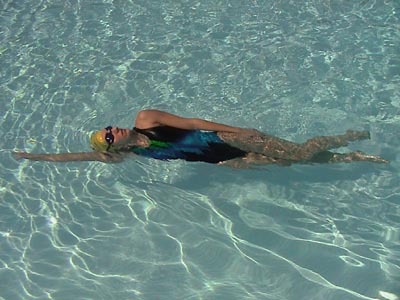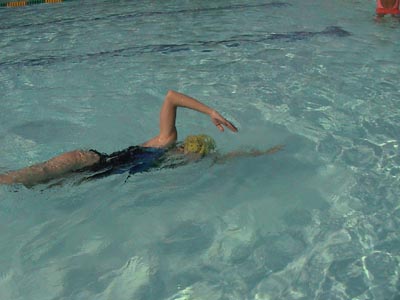 |
|  Drills to Perfect Swimming Balance November 1, 2001
by Coach Emmett Hines, Ph.D. This article is a continuation of the "How to Spend the Off-
Season" article in the November issue of Runner Triathlete News.
For complete details on the improving your swimming, please pick
up a copy of the November 2001 edition of Runner Triathlete
News.
These two drills are designed to help you learn excellent balance and then to get used to maintaining that balance as you take strokes.
Streamlined Side-Gliding Balance (or, simply, Side Glide)
Drill
Turn your head so that your nose is pointed toward the bottom of
the pool with just the back quarter (or less) of your head
exposed to the air. Exhale some, but not all, of your air
underwater. As you finish exhaling, turn your head back to the
nose-up position. Take several breaths in this position before
turning your head to do another underwater exhalation. The body
should stay in the same balanced side-lying position throughout
the drill. The whole idea is to rotate your head as if it is on
a skewer (through your crown and along your spine) without
bending the skewer. Feel for that dry strip of flesh all the way
down your side arm from shoulder to wrist at all times. If you lift the head at all or allow the extended arm to fall
toward the bottom as the head turns for the breath the hips will
drop and you'll feel the water line creep up your side arm
toward your shoulder, indicating you have lost balance. The cure
is to be aware of keeping the extended arm "weightless" and
stretched straight toward the far wall. Try to have contact, or
very little daylight, between the back of your head and the
extended arm. You can even think of lifting the extended arm
slightly, perhaps one inch, toward the surface as you rotate the
head to breathe. This drill should be done on both sides.
3 & Glide Drill
Each time you finish a roll and stroke you should be aware of
your belly button pointing directly toward the sidewall just as
it is when in Side Glide position. As you finish the third
stroke of each set and hold the Side Glide position you want to
immediately feel the dry strip of flesh down your trailing arm.
If not, this tells you that you either lifted your head up or
let pressure off of your buoy or both. Make any correction
necessary and spend enough time in the Side Glide position to
think through any change you need to make on the next set of
three strokes.
Emmett Hines is Head Coach of H2Ouston Swims. He has coached competitive Masters swimming in Houston since 1982 and is a Senior Coach for Total Immersion Swim Camps. His book, Fitness Swimming (Human Kinetics, publishers), is in its second English language printing and has been released in Spanish, French and Chinese. Currently he coaches the H2O Masters group in the River Oaks area, works privately with many clients and offers video stroke analysis by mail (Project VDO). You can find more of his articles at www.H2OustonSwims.org and he can be reached for questions or comments at (713) 748-SWIM or [email protected].
About Runner Triathlete News | About Running Network | Privacy Policy | Copyright | Contact Us | Advertise With Us |
|
|

